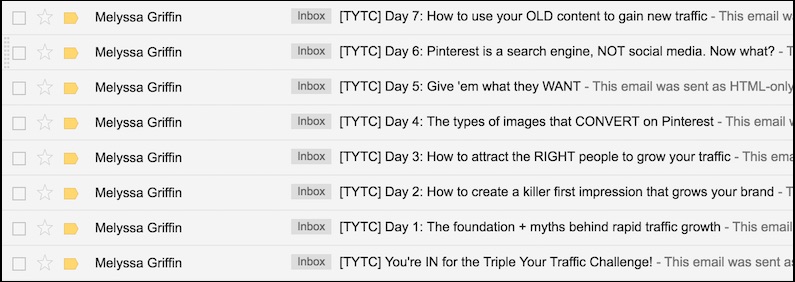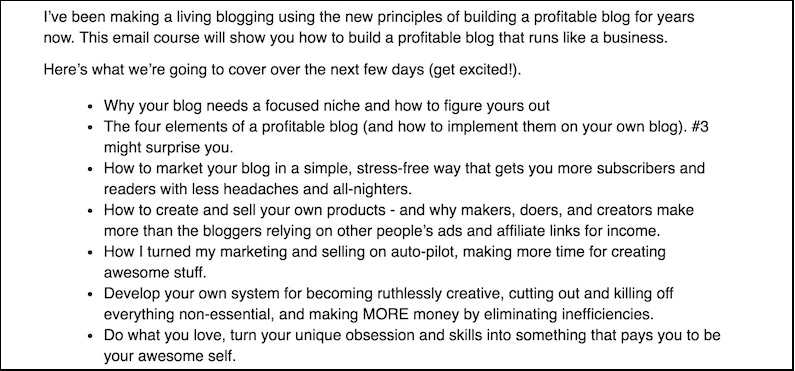It seems like everywhere I turn right now, I’m being asked to join a new email mini-course.
Not that I mind. I’ve signed up for a few. Receiving easy-to-consume lessons over the course of a week or so can be a great (and free) way to get familiar with a new topic. When those emails are loaded with insights, statistics and tips for various areas of marketing—the field I work in and am interested in learning more about—what’s not to love?
But not every email course I tried was a winner. Sometimes the writing wasn’t compelling, or the emails were way too long. One course was a full 30 days long, and I only made it to day 11 before I unsubscribed.
More often, though, the less compelling email courses were just not providing helpful, actionable information. Instead of creating a truly helpful course, some marketers clearly didn’t want to share any real information until I purchased. Obviously, I did not come to see these people as authorities, and I clicked unsubscribe before they could even send me a sales pitch.
So how do you keep subscribers engaged enough that they can’t wait to convert at the end of the course?
I reached out to our in-house email course specialist, Ian Garoian, to get the tips that will help you create an email mini-course that engages and converts.
But first, you might be wondering: is building a free email course worth the effort?
I think so. Done well, email courses help you build trust and be seen as an authority among new subscriber. Even if your leads don’t convert right away after your course, you’ve built a list that’s used to seeing you in their inbox, and has gotten something useful from your emails. I’d be willing to bet that your email course will boost newsletter open rates and, eventually, those email course leads will be more likely to purchase from you.
The trick, as with any free content (blogs, podcasts, or lead magnets) is to balance giving away free information with building the case for purchasing your product. It’s not an easy balance to achieve, but Ian’s here to help. Here are the top three things he keeps in mind when he’s helping craft email courses that convert.
1. Build the perfect course for your ideal customer.
This might sound like Marketing 101, but when you’re building an email course, you need to have a clear picture of who your ideal customer is and what problems they face that you can help solve.
“I mean, really think about who your target audience is,” says Ian. “You have to have that in mind before you send content out there, or you’re just shooting in the dark.”
You can start by focusing in on the problem you are hoping to solve for your ideal customer and build your course around that exact problem.
The key is to provide enough help that your ideal customer gains a newfound understanding or view of their problem, and provide tips and tricks for how they can address the problem on their own. But you also want to prime your audience to see why they need the solution you are offering (in the form of the product or service you are selling).
In her Triple Your Traffic Challenge email mini-course, course creator (and Converted 2016 speaker) Melyssa Griffin focused on tactics for growing blog traffic using Pinterest. She kept her course tailored to the problems bloggers face trying to grow their traffic.

As you can see from the subject lines of her emails, Melyssa formed each lesson around a distinct aspect of using Pinterest to get traffic. Inside, subscribers received tangible action-based homework each day. At the end of this course, she had cultivated an audience that understood the importance of Pinterest and had begun to implement strategies to grow their Pinterest marketing efforts.
In short, she’d created an audience of perfect students to enroll in her Pinfinite Growth course, which she emailed her mini-course audience about the day after the course ended.
Bonus tip: Melyssa also kept my inbox easy-to-organize by clearly labeling each email subject line with [TYTC] (which stands for Triple Your Traffic Challenge) and the day. This consistency helped her email stand out from the slew of other messages that pop up in my inbox every day.
2. Keep your eye on the prize when building your course.
One of the biggest mistakes that Ian sees when working with customers to create email courses is that their content isn’t cohesive. “You want everything to be concise, so all the emails fit together, they have good flow from the first to the last, and each one gives somebody a new thing to think about every day,” he says.
It can help if you start with an outline. For instance, in her Build a Profitable Blog email mini-course, Femtrepreneur’s Mariah Coz outlines what you’ll learn right in the “welcome to the course” email, which pops into your inbox right after you sign up. Each lesson has a different focus, but they all create a cohesive course because they are super focused on making money from blogging.

Your email mini course should center around a topic that you want new leads to see you as an authority on, so that your business will be the first place you turn when they want to move forward.
3. Structure your course around your evolving goals.
Now that you have a laser focus on your ideal customer and course topic, you’re probably wondering how to actually structure your course. The structure of your course should come back to your goals.
Your goals early on in the email course are not the same as your goals at the very end of the course. While you might want to make a sale in the end, you won’t get a chance to even make a sales pitch if you can’t prove to your leads that you are an authority on the topic.
First, think about the existing content you have on your email mini-course course topic, like blog posts that are already up on your site. If you’ve been creating content for more than a few months, you probably have all you need to put together a lesson sequence. Reworking your existing content will save you some time—plus, your new leads probably haven’t read everything on your blog anyway.
Ian recommends keeping each email between 500 and 1,000 words. That means some of your most in-depth blog posts could provide two or three email lessons. Aim for about 5–7 days of content—it’s all you need for a truly focused course, and you don’t want to bore your leads. You want to turn them into customers as soon as they have enough information to convert.
The first email: For the first few days of your email mini-course, write as though your main goal is to get the reader to open the next email.
That means that your first email has to be loaded with helpful content. The first email is a great place to outline the problem that your ideal customer is facing. Depending on what it is, you can show them why it’s such a struggle, share statistics on how many people are facing this challenge, or tell a story of when you had the same problem.
You can—and even should—mention your for-sale products or services in this email. But at the outset, you should treat this as a “fast track” option for subscribers who are more advanced or ready to take action.
The next few emails: From here on out, every email should contain helpful educational content and actionable steps. If you’re selling an e-course or an educational product, don’t worry about giving away all of your secrets for free. You can hold on to some of your very best tips, but know that there will always be people who want more in-depth education or high-touch help customized for their goals.
These people will become your customers at the end of the course if they’re confident that you’re the expert that can help them, so focus on proving your expertise. You can help ensure that your readers open the next email by ending each email with a cliffhanger or a teaser of what you’re sending tomorrow.
The final email: On the last day or two, or even in another email after the course has ended, you can show off your product, course, or services in greater depth. This is your chance to explain why you have the solution that will solve their problem, and why it’s the best way to implement what they’ve already learned in the course.

In the Drip email mini-course, Rob Walling outlines the importance of marketing automation before he even mentions Drip in the “Drip vs. Everyone Else” email on Day 6. By Day 6, leads are sure enough that marketing automation is the solution they need that they’re ready to hear about the benefits of Drip’s specific platform. By Day 7, they’re ready to give it a try.
By now, you’re probably raring to get out there and create an email mini-course of your own. Remember, if you sign up for Drip at the Basic level or higher, you can have our customer success team build a custom 5-day email course for you.
Have you taken any great email courses? Let me know in the comments which ones were super effective!



